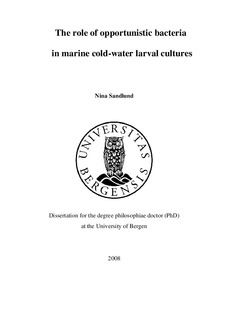| dc.description.abstract | The cultivation of marine larvae is often associated with high rates of mortality and is regarded as a bottle-neck in maintaining stable levels of production of juveniles for on-growing. In the course of the past few decades a great deal of effort has been put into increasing the production of farmed marine species. In spite of this, production is still low, compared to the production of salmonids, partly due to problems that arise during the early stages of life. The mortality problem is thought to be caused by bacteria that originate either from larval or live feed cultures. These are systems with high densities of biological waste and debris which may contribute to the growth of opportunistic bacteria. Vibrio spp. have often been suggested as causal agents. Because of the complex microbiological composition involved in larval and live feed cultures, and the small size of the larvae and feed organisms, isolating bacteria and describing their roles may be demanding. In order to identify pathogenic bacteria, reliable infection models are needed. The aim of this thesis is to enhance the knowledge of the bacteria associated with the cultivation of marine species.
Experimental model organisms were great scallop Pecten maximus, cod Gadus morhua, halibut Hippoglossus hipposlossus, and turbot Scophthalmus maximus. The present work utilizes the multi-dish system as a model for bath challenge experiments using several species of marine larvae (Papers I-III, V). The method is reliable and efficient both as means of minimizing the number of larvae needed and for saving time and work space. It also provides individual control. In Paper I, six candidates of bacteria pathogenic to great scallop larvae were tested. In a similar experiment with cod larvae, 53 bacterial strains were tested for virulence (Paper II). Both studies included two controls i.e. unchallenged larvae as negative control and one larval group challenged with a known pathogen Vibrio pectenicida (Paper I) and Vibrio anguillarum serotype O2α (Paper II) as positive control. In addition to the positive controls, Vibrio splendidus (Paper I), four different strains of V. anguillarum and Carnobacterium sp. strain were verified as highly pathogenic (Paper II). The attempt to serotype the V. anguillarum strains produced inconclusive results (Paper 12 II), and further studies are needed. The study described in Paper II also show that most bacteria associated with diseased fish is not a primary cause to disease. Studies of the susceptibility of cod, halibut and turbot larvae to various serotypes of V. anguillarum and Vibrio spp. produced high mortality in all groups challenged with the O2α serotype. Cod and halibut larvae also suffered high mortalities when challenged with O1 (Paper V). The immunohistochemical examinations of larvae challenged with serotype O2α showed little or no pathology, leading to the hypothesis that extracellular products or toxins were killing the larvae (Paper III, V). Serotype O1 caused severe pathology (Paper V). | en_US |
